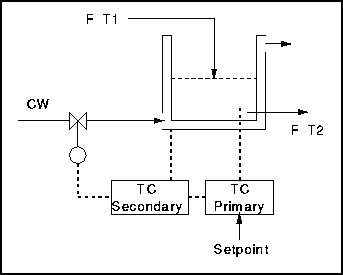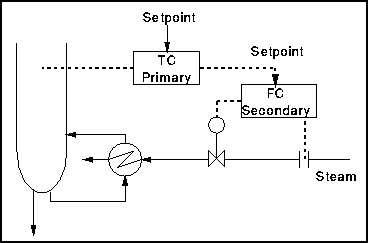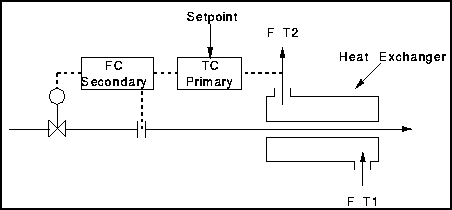Cascade Control
The second alternative to simple feedback control is cascade control . In this setup there is
- one manipulated variable
- more than one measured variable
An inner and outer control loop are formed each with an individual feedback controller. The outer loop controller is also known as the master or primary controller.
- The input to this controller is the measured value of the variable to be controlled.
- The setpoint is supplied by the operator.
- It passes its output signal to the inner control loop.
The inner loop controller is known as the slave or secondary controller.
- It measures a second variable whose value affects the controlled variable.
- The setpoint is supplied by the output from the outer loop.
- Its output signal is used as the signal to the manipulated variable.
The above points can be shown clearly in a diagram.

The major benefit from using cascade control is that disturbances arising within the secondary loop are corrected by the secondary controller before they can affect the value of the primary controlled output.
Cascade control is especially effective if the inner loop is much faster than the outer loop and if the main disturbances affect the inner loop first.
Below are described examples of cascade control in practise. It should be noted that in two of the three examples, the secondary loop is used to compensate for flowrate changes. In process systems this is generally the case.
Example 1 - Reactor Temperature Control

In this example the aim is to keep T2 at its setpoint. The primary control loop detects and eliminates changes in T1, the temperature of the reactants. The secondary control loop detects changes in the temperature of the cooling water.
Hence it can adjust the flow accordingly before the effects are detected by the primary control loop. If there was no second controller the effect of the cooling water would take a long time to materalise and hence eliminated.
Example 2 - Distillation Bottoms Temperature Control

In this example the primary loop detects changes in the temperature brought about by changes in composition, pressure, etc.
The secondary loop detects changes in the steam flowrate and hence eliminates anticipated effects on the temperature.
Example 3 - Heat Exchanger Temperature Control

This is similar to example 2. The aim is to keep T2 constant. Again the secondary loop is used to compensate for flowrate changes.